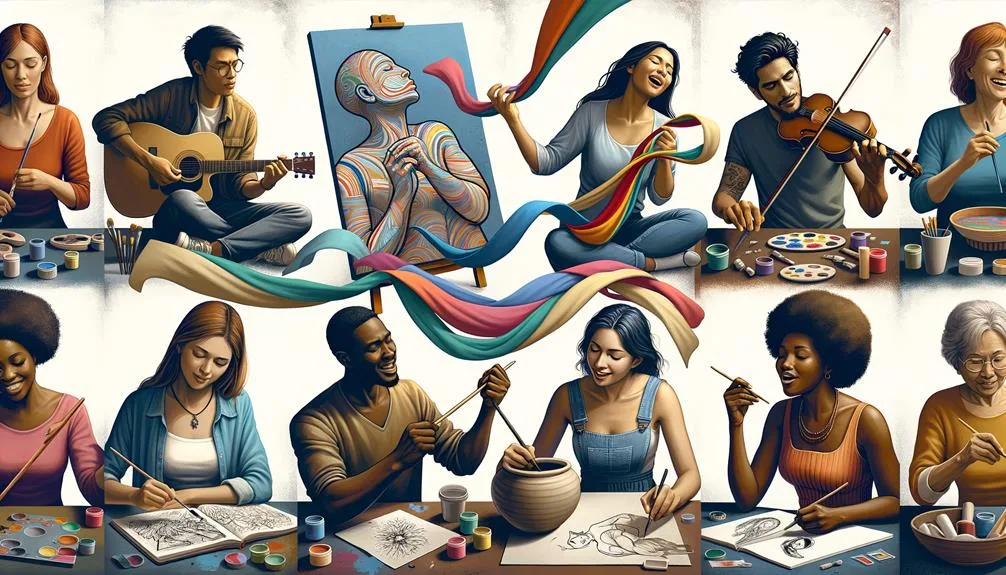Unlock the door to your creative potential and step into a world where your imagination takes flight. Just like a painter with a blank canvas or a musician with a melody waiting to be composed, you possess a reservoir of untapped creativity within you.
But how can you access and unleash this hidden power? Through the transformative techniques of expressive arts therapy, you can discover a pathway to self-expression, emotional healing, and personal growth.
In this discussion, we will explore the captivating world of expressive arts therapy techniques, offering you a glimpse into the possibilities that lie ahead. Prepare to embark on a journey of self-discovery and artistic exploration that will leave you yearning for more.
Key Takeaways
- Expressive arts therapy incorporates multiple forms of creative expression into psychotherapy, allowing clients to articulate their inner world and promote the mind-body connection.
- Expressive arts therapy differs from creative arts therapy in that it integrates various creative arts therapies into a multimodal approach, while creative arts therapists specialize in one specific area.
- Techniques used in expressive arts therapy include drawing, painting, sculpting, movement, writing, poetry, and role-play, all of which can be powerful forms of self-expression and stress relief.
- Training programs and degrees are available for those interested in becoming expressive arts therapists, offering comprehensive training in interpreting creative expression and facilitating multimodal creative expression.
Benefits of Expressive Arts Therapy
Expressive Arts Therapy offers a multitude of benefits that can enhance your emotional well-being and promote personal growth. The healing power of creativity is a fundamental aspect of this therapeutic approach.
Through various art forms such as painting, drawing, sculpture, and music, you have the opportunity to harness your emotions and express them in a safe and non-judgmental space. Art becomes a powerful tool for self-expression, allowing you to explore and process your inner world.
By engaging in the creative process, you can gain insight into your thoughts and feelings, develop coping mechanisms, and find new ways to communicate your experiences. The act of creating art can be cathartic and transformative, providing a means to release emotions, heal from past traumas, and cultivate a deeper sense of self-awareness.
Through expressive arts therapy, you can tap into the healing power of creativity and embark on a journey of self-discovery and personal growth.
Exploring Different Forms of Creative Expression
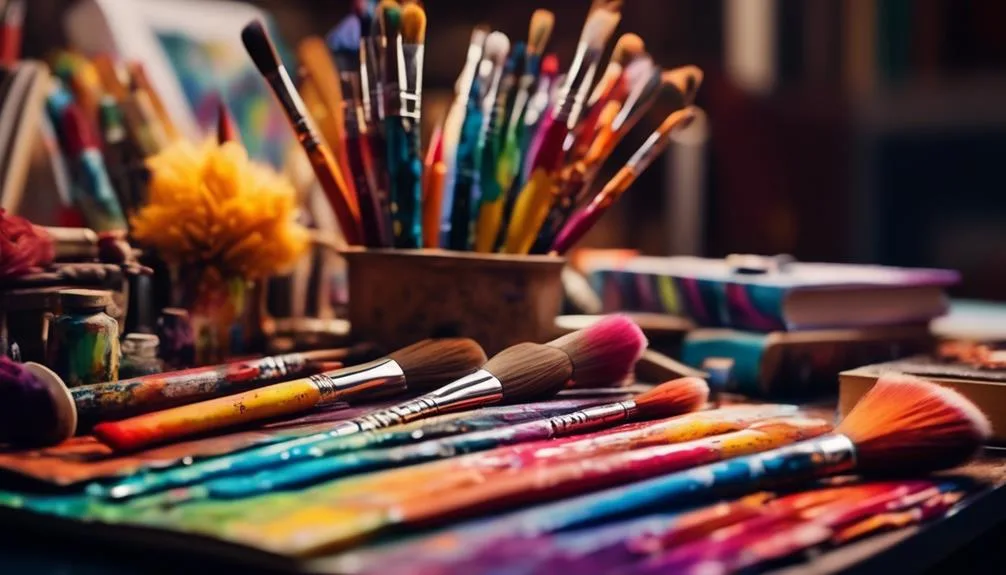
Engaging in different forms of creative expression allows you to tap into the depths of your inner world and discover new avenues for self-discovery and personal growth. Here are some powerful ways to explore your creativity and promote healing:
- Self-portraiture as therapy: Through drawing, painting, sculpture, or photography, you can create a visual representation of yourself, reflecting personal growth and transformation over time. This process provides a creative outlet for self-expression and can be used in therapy sessions.
- Therapeutic photography techniques: Also known as photo therapy, this form of creative expression enhances your appreciation of the environment and daily life. It can be used to journal the healing process after trauma or loss, helping individuals recover from depression and anxiety.
- Mandala making or coloring: Derived from the Sanskrit word for circle, mandalas are meditative exercises that promote emotional expression, centering, and self-soothing. Whether created from scratch or using coloring books, mandalas provide stress relief and relaxation.
- Filmmaking: Accessible to most people, filmmaking is a powerful expressive art form that can be done using smartphones and video-editing apps. It has been used in psychotherapy to treat post-traumatic stress disorder and integrated with various therapeutic approaches for psychological healing.
Explore these different forms of creative expression to unlock your inner creativity, promote self-discovery, and embark on a journey of personal growth.
Techniques for Individual Therapy Sessions
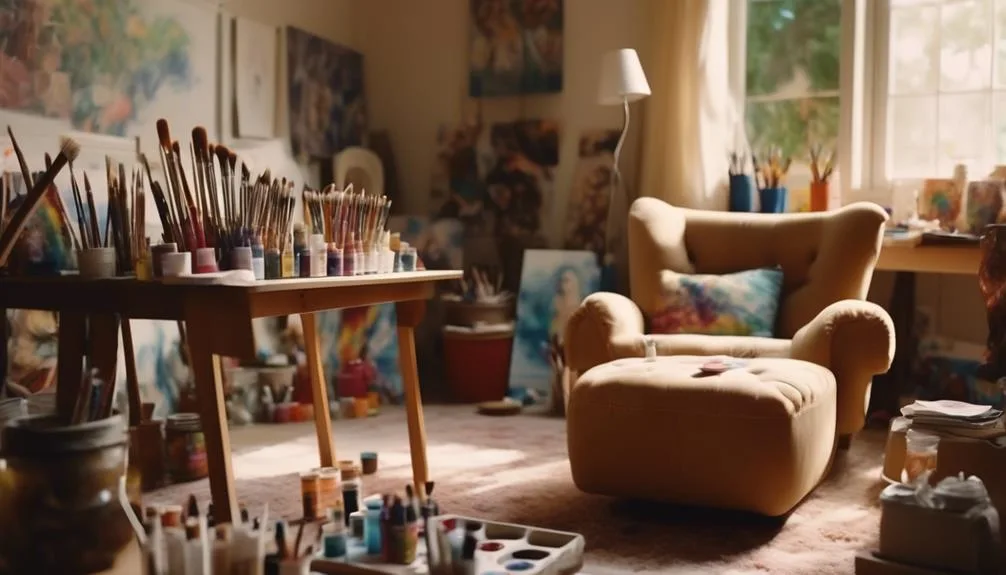
In individual therapy sessions, you can explore various expressive arts therapy techniques to foster self-discovery, emotional expression, and personal growth. One technique that can be particularly beneficial is self-portraiture. Creating a self-portrait through drawing, painting, mask making, sculpture, photography, or mixed media allows clients to reflect on their personal growth and explore how they see themselves changing over time. It provides a creative outlet for self-expression and can be cathartic. Another technique to consider is incorporating movement into individual sessions. Movement can be a powerful form of self-expression and stress relief. Encouraging clients to engage in activities such as dancing, yoga, or tai chi can help them connect with their bodies and release pent-up emotions. By incorporating these techniques, you can support your clients in their journey of self-discovery and emotional healing.
| Techniques for Individual Therapy Sessions | |
|---|---|
| Benefits of Self-Portraiture | Incorporating Movement in Individual Sessions |
| – Provides a creative outlet for self-expression | – Movement can be a powerful form of self-expression and stress relief |
| – Allows clients to reflect on personal growth | – Dancing, yoga, or tai chi can help clients connect with their bodies |
| – Can be cathartic and reflective | – Releases pent-up emotions |
| – Explores how clients see themselves changing over time | – Supports emotional healing and self-discovery |
Activities for Group Therapy Sessions
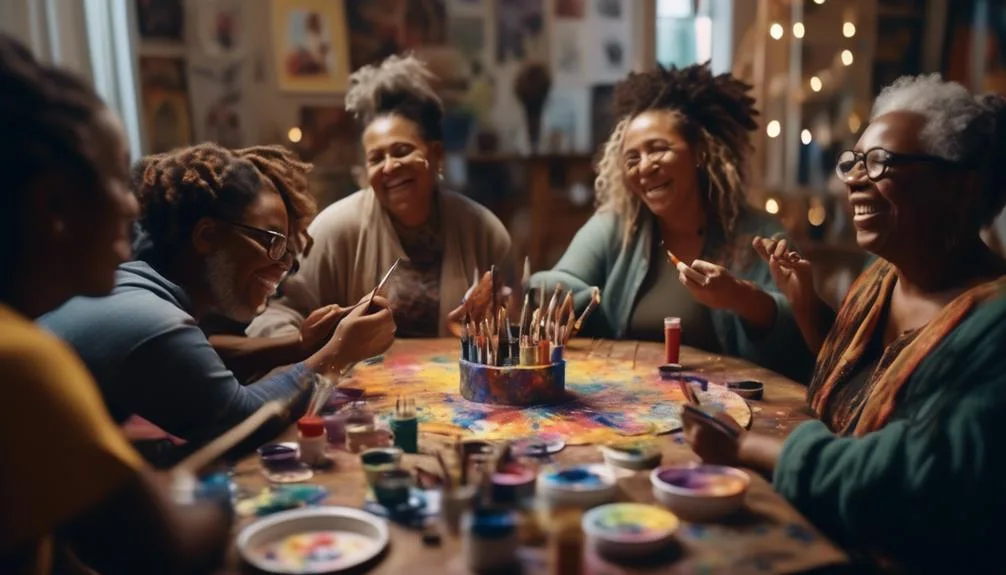
As you continue to explore techniques for individual therapy sessions, you may also want to consider incorporating activities for group therapy sessions, fostering connection and collective healing. Group therapy activities can be a powerful tool for promoting self-expression and creating a sense of community among participants. Here are four activities that you can incorporate into your group therapy sessions:
- Collaborative art project: Encourage the group members to work together on a large art piece, such as a mural or a collage. This activity promotes teamwork, communication, and creativity.
- Guided group meditation: Lead the group through a guided meditation session, focusing on relaxation and mindfulness. This activity allows participants to connect with their inner selves and create a sense of calm and unity within the group.
- Storytelling circle: Create a safe space for group members to share their personal stories and experiences. This activity promotes empathy, understanding, and validation among participants.
- Group movement therapy: Incorporate movement and dance into the group therapy session. This activity allows participants to express themselves non-verbally and release emotions through their bodies.
Resources for Training and Further Learning
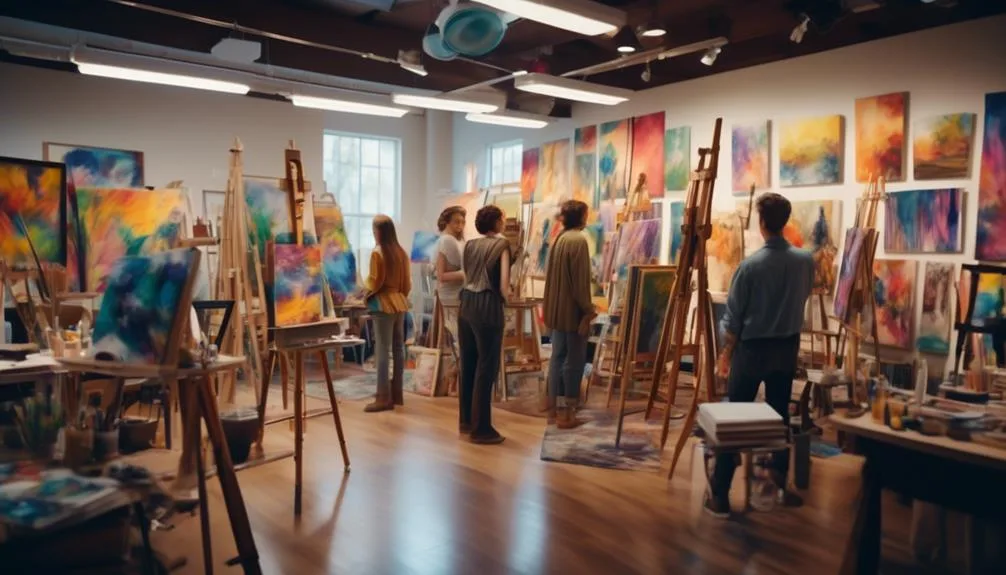
To further your knowledge and skills in expressive arts therapy, there are a variety of resources available for training and continuing education.
If you're interested in pursuing a career as an expressive arts therapist, you can explore different expressive arts therapy programs and degrees. These programs provide comprehensive training in the use of creative expression in therapy, including how to interpret creative expression and facilitate multimodal creative expression. They emphasize the integration of expressive arts into psychotherapy and often include supervised clinical experience.
Additionally, there are expressive arts therapy books available that can deepen your understanding of the field and provide practical techniques for incorporating expressive arts in therapy sessions.
These resources can help you expand your expertise and enhance your ability to support clients in their healing journey.
Frequently Asked Questions
How Can Expressive Arts Therapy Benefit Individuals With Specific Mental Health Conditions?
Expressive arts therapy offers innovative approaches to trauma healing and benefits individuals with mental health conditions. Through creative expression, it allows you to explore and communicate your emotions, promoting self-awareness, healing, and personal growth.
What Are Some Unique Ways That Expressive Arts Therapy Can Be Used to Address Trauma and Promote Healing?
Unleash your creativity and heal through artistic expression. Explore unique techniques in expressive arts therapy to address trauma. Discover the power of collage, self-portraiture, photography, mandala making, and filmmaking to promote healing and transform your journey.
Are There Any Specific Populations or Age Groups That Can Benefit the Most From Expressive Arts Therapy?
Specific populations and age groups that can benefit the most from expressive arts therapy include children, adolescents, adults, and older adults. It can help with trauma, mental health issues, self-expression, personal growth, and overall well-being.
How Does Expressive Arts Therapy Differ From Traditional Talk Therapy Approaches?
Expressive arts therapy differs from traditional talk therapy by integrating various forms of creative expression. For example, a client who struggles to verbalize their feelings may find relief through painting, allowing for deeper exploration and healing. This approach can be highly effective in accessing and processing emotions that may be difficult to express verbally.
Can Expressive Arts Therapy Be Used as a Standalone Treatment or Is It Typically Used in Conjunction With Other Therapeutic Modalities?
Expressive arts therapy can be used as a standalone treatment or in combination with other therapeutic modalities. It offers a unique approach to healing, allowing you to explore and express yourself creatively, promoting self-awareness, personal growth, and emotional well-being.
Conclusion
So, you've reached the end of this article on expressive arts therapy techniques. Congratulations!
Now that you've been introduced to this transformative and creative form of therapy, it's time for you to unleash your inner artist and embark on a journey of self-expression and personal growth.
Remember, the power of art lies within you, waiting to be discovered.
So, go forth and let the rhythm of your creativity flow, as you tap into the therapeutic benefits of expressive arts therapy.

